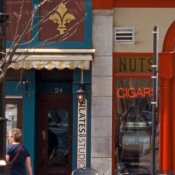2F/2F
Member
Glad this thread is continuing. I'll admit, I don't use PS much for image editing, but I got curious when reading about Camera Raw. So I booted PS and loaded a raw image. Geez luiz, I've been used to Canon's DPP, which I've always thought was plenty good enough, but with Camera RAW, it appears that almost all necessary corrections can be done at the raw level before saving the file to a given file format. Wow. DPP is handy for translating quantities of files over to other formats, though. I guess CR can do this too?
Absolutely, it can.
1) Find files to work on using Bridge, and highlight them simultaneously.
2) Hit Command-R, and they will all come up in Camera Raw.
3) Do what you need to do to the pix. You can do pretty much everything, including burning, dodging, and sharpening (including sharpening masking). Be sure to mess with the tool...and forgive me, because I forgot it's name and I don't have the program in front of me...that looks like a brush. It basically allows you to make several separate burning, dodging, saturation, etc. adjustment layer masks using a brush tool, and then edit them after the fact with sliders, while looking at the image. It is a very powerful tool.
4) At the bottom of the Camera Raw screen, there is a line of text that will list the specifications of the image, such as 8 bit, so many by so many pixels. Click that. A window will pop up. Choose the bit depth of the files you want to convert to. Don't use any of the + or - settings unless you want to roughly resize the pix. For doing prints, I choose 16 bit conversion. For pix that I know are only going to be digital, I use 8 bit.
5) In the strip of thumbnails over to the left, highlight all the pix you want to convert.
6) Below the strip of images, click SAVE PICTURES, or whatever the button says.
7) Choose your file type, location, and batch rename the files if you want.
8) Hit OK in the popup window. You will be taken back to Camera Raw and you will see a tiny countdown in the bottom left that says "X remaining." When that finishes, all your files have been converted, renamed, and placed in the folder you chose.
9) Make sure you click DONE to save the changes you have made to your sidecar (.xmp) files. If you don't, all the adjustments you have worked so hard on in Camera Raw are thrown away.
It is a very powerful program. I only have to use Photoshop for resizing, major manipulation work (rare with what I shoot), minor adjustments when test stripping, and printing, of course.
P.S. When you first open your pix in Camera Raw, hit the F key. It is much easier to work this way with this particular program, IMO.
Also, be sure to tinker with the b/w conversion in Camera Raw. It is a very good way to convert to b/w. Use manual, not auto.
And make good use of snapshots. They can be lifesavers.
Last edited by a moderator:

















